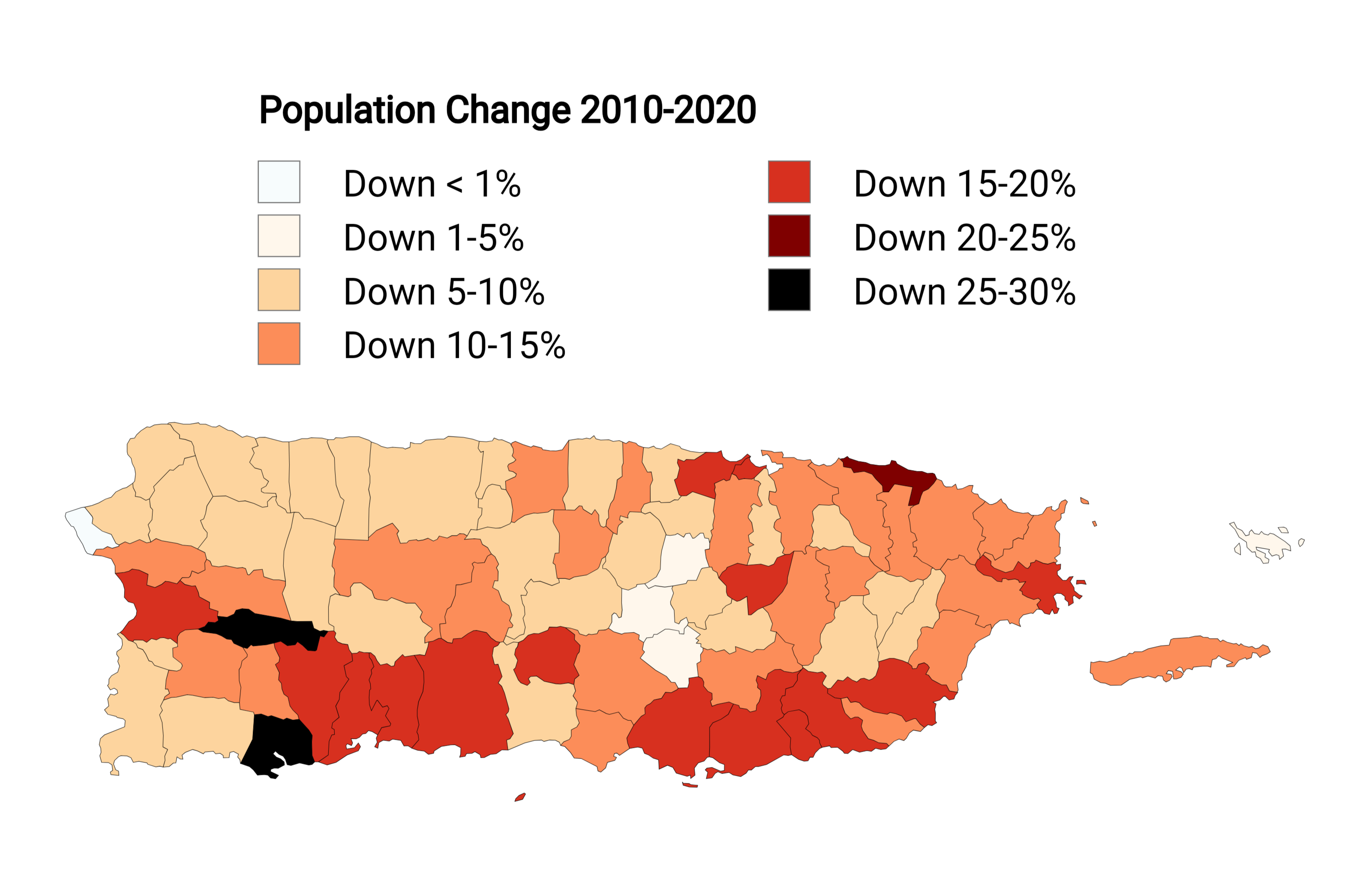Puerto Rico Population Decline Map 2010-2020


David Chen
Data Visualization Specialist
David Chen is an expert in transforming complex geographic datasets into compelling visual narratives. He combines his background in computer science ...
Geographic Analysis
What This Map Shows
The visualization titled "Puerto Rico's Population Decline (2010-2020)" offers a stark representation of demographic shifts across the island over the past decade. It highlights the areas experiencing the most significant declines in population, with darker shades indicating larger losses. This map serves as a visual testament to a complex set of socio-economic factors impacting Puerto Rico, from economic challenges to outmigration trends. By examining the underlying issues that contribute to this decline, we can gain a deeper understanding of the demographic landscape of Puerto Rico.
Deep Dive into Population Decline
Population decline is a critical issue for many regions around the world, but Puerto Rico presents a particularly poignant case. Between 2010 and 2020, the island experienced a dramatic drop in population, with estimates indicating a decrease of approximately 11.8%. This trend has been attributed to several intertwined factors, including economic stagnation, natural disasters, and emigration.
Economically, Puerto Rico has faced significant challenges, particularly following the economic recession that began in 2006. The island's economy, heavily reliant on manufacturing and tourism, has struggled to recover, leading to high unemployment rates and limited job opportunities. In this environment, many residents have sought better prospects on the mainland United States, contributing to a steady outflow of people. Interestingly, the U.S. Census Bureau noted that migration to the U.S. mainland accounted for nearly 85% of the population decline recorded in the last decade.
Moreover, the devastation wrought by Hurricane Maria in 2017 cannot be overlooked. The hurricane caused widespread destruction, displacing thousands and prompting many to relocate permanently. The aftermath of the storm exacerbated pre-existing economic issues, leading to further outmigration as residents sought stability elsewhere. These factors, combined with a declining birth rate, have resulted in a shrinking population. In fact, the decline in births has been a consistent trend in Puerto Rico, as families face economic uncertainty and choose to delay or forgo having children.
What’s fascinating is that this population decline isn't uniform across the island. Urban areas, particularly San Juan, have seen more significant declines compared to rural regions. This urban-rural divide raises questions about the future of urban centers in Puerto Rico and whether they can rebound in the years to come.
Regional Analysis
Examining the map more closely reveals regional disparities in population decline. For instance, San Juan, as the capital and largest city, has experienced substantial losses, with a population decrease of over 20% in certain neighborhoods. This trend reflects not only the economic challenges but also the aging infrastructure and housing issues that have made urban living less desirable.
In contrast, regions like Ponce and Mayagüez have shown varied levels of decline, with some areas experiencing slight upticks in population due to local initiatives aimed at revitalizing communities. Interestingly, places like Caguas have managed to maintain more stable populations, attributed to local government efforts that encourage development and attract new residents.
The map also indicates that the western part of the island, while facing declines, has not been as severely impacted as the metropolitan areas. This could be attributed to lower cost of living and a slower pace of life that appeals to some residents looking for a change from urban pressures.
Significance and Impact
The implications of Puerto Rico's population decline are profound. On a societal level, a shrinking population can lead to a reduced workforce, which in turn affects economic productivity and growth. This creates a cycle that can be hard to break; as more people leave, job opportunities diminish, prompting even further outmigration.
Moreover, the decline impacts public services, infrastructure, and funding. With fewer residents, local governments may struggle to maintain essential services, leading to a decline in quality of life for those who remain. What’s even more concerning is that this trend can perpetuate a feeling of abandonment among residents, leading to a collective sense of hopelessness.
Looking ahead, projections suggest that unless significant changes occur—such as economic revitalization, improved job opportunities, and recovery efforts in the wake of natural disasters—Puerto Rico's population decline could continue. The island's future hinges on its ability to attract and retain residents, fostering an environment where families feel secure enough to stay and grow.
In summary, the population decline in Puerto Rico is not just a statistic; it reflects the realities of life on the island and the challenges faced by its residents. Understanding these dynamics through maps like this one can help policymakers, researchers, and citizens alike to engage in meaningful discussions about the future of Puerto Rico.
Visualization Details
- Published
- September 26, 2025
- Views
- 52
Comments
Loading comments...